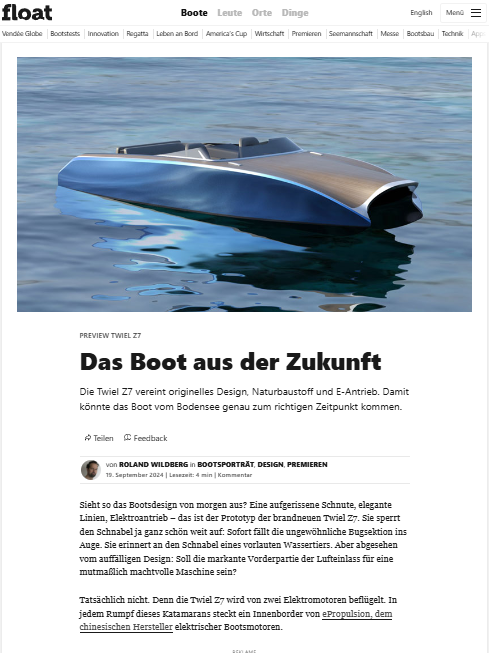The Twiel Z7 Combines original design, natural building material and electric drive. This means that the southern German boat could come at exactly the right time.
Is this what tomorrow’s boat design looks like? A torn up, elegant lines, electric drive – this is the prototype of the brand new ones Twiel Z7. She opens the beak quite far: the unusual bow section immediately catches the eye. It is reminiscent of the beak of a cheeky aquatic animal. But apart from the eye-catching design: should the distinctive front section be the air intake for a presumably powerful machine?
Actually not. Because the Twiel Z7 is inspired by two electric motors. In every hull of this catamaran is an inboard from ePropulsion, the Chinese manufacturer of electric boat motors. It is the middle drive Epropulsion i20 with 20 kW, the equivalent of 27 hp. It came onto the market in 2023, so just in time for that Twiel project.
The southern German company began three years ago Mizu Navy by Michael Zupritt in Hilzingen near Singen with the conception of the new boat. It is about ‘nothing less than the creation of a new ship concept, the implementation of new technologies and at the same time the introduction of a new driving experience and driving pleasure’. Of course, such a sentence raises high expectations.
The Twiel is aimed at Lake Constance
And the full-bodied statement – literally – also goes well with the sensational design. It resembles a wave. Everything flows – symbolically – in the hull of the Z7. That is, in the two hulls, because the twiel drives on a double keel. Incidentally, the Hohentwiel was the godfather for the name. This is the distinctive local mountain of Hilzingen. Beyond that, further east, is Lake Constance. The customers of the new motor catamaran awaits Pritt there.
Because on the second largest natural lake in Central Europe, the demand for electric boats could grow stormily in the foreseeable future. As early as 2040, boats, yachts and ferries are to be operated completely emission-free there. Germany, Austria and Switzerland, the three residents of the international body of water, recently agreed on that.
Michael Zupritt wants to offer his answer tailored to the upcoming provisions as soon as possible. The face makes them unmistakable, the flowing lines are pleasing, and with 54 hp on two slender hulls, the expected pace should also be fun. The shipyard explicitly describes the boat as a glider – respectable performance at the relatively low power. This is achieved by the two-hull design.
The hull construction keeps what drive and appearance promise. The Twiel has a grid frame made of plywood, thus combining sustainable materials and modern lightweight construction. Hans-Jürgen Kaiser from Strasskirchen in Lower Bavaria, Lower Bavaria, already shows that sophisticated designs and high drive power can also be married to each other in its elegant runabouts. And in the sailing area, Jan Bruges also wants to provide proof with the Woy 26.
Technical data Twiel Z7
Length: 7.90 m Draft: 0.60 m
Width: 2.55 m Motor: ePropulsion i20 electric motor, 2 x 20 kW (27 hp each)
Weight: 1.6 t Maximum crew size: 6 people
Double hull is almost invisible
The Twiel makes an interesting combination of retro classical and bionics on the subject. ‘The patented hull shape lets you glide gently through the water and ensures a comfortable ride.’ Its constructive feature: The double hull principle, which is supposed to bring your efficiency and safety, is almost invisible, almost hidden in the overwater ship. If you will, Zupritt has hidden the cat under an elegant body.
The front third radically decouples the design principle ‘form follows function’. This is cheeky, and at the same time immensely sympathetic at a time when a lot has to be subordinate to the greatest possible benefit. Here the beak, which bulges over the two hulls, grows into aesthetic peculiarity. The Twiel will be easy to find among a hundred other boats in the marina. The front end is also reminiscent of historic compressor sports cars of the 1930s – the apparent engine hood together with the indicated fenders (without wheels behind them). With a little imagination, there are even parallels to the most famous of all ‘silver arrows’, that Mercedes racing car with a streamlined W 196 from 1955.
Of course, the Twiel shouldn’t set any speed records – above all, it should be fun. ‘On board the Twiel, the skipper becomes a captain again.’ For the weekend trip with family and friends on the water, who find sixth place in the deliberately simple cockpit area. The shipyard names pine and mahogany as building materials.
Electric catamarans are on the rise
The Twiel Z7 is a new approach to pack the catamaran’s efficiency benefits into an attractive design. A striking recent design comes from Frauscher: The Timesquare. And de Antonio has also developed an exciting catamaran concept with the E23, which float will present shortly. The Four Winns TH 36 and the best-of-boats award winner Prestige M 48 with multihull concepts come up with classic motorized motor boats.
It’s true: many are skeptical about the catamaran construction, although it has so many advantages. Most of the time it’s about aesthetics. Boat builders often try to clear this up by concealing this peculiarity of the two hulls. Zurittt goes one better, so to speak. With the idiosyncratic design, he succeeds in making such a striking eye-catcher that the double keel looks completely into the background.
The first illustrations from the Twiel promptly awaken the expectation that this boat will aesthetically match the classic monohull principle. In January 2025 it will be presented at Boot Düsseldorf. It will be interesting to see whether Mizu Marine convinces customers. In any case, we can’t wait to go on the water ourselves with the Twiel Z7.
This text was first published on Float on July 17th. Updated September 19, 2024.

